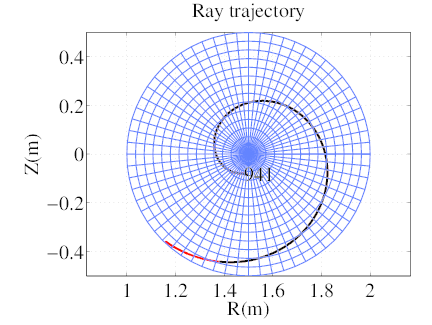
In Reverse Field Pinch, the plasma evolves to a quasi-stationary magnetic equilibrium close to the force free minimum energy states described by Taylor [17]. The fully relaxed Taylor states are characterized by
 | (194) |
with
 | (195) |
constant throughout the plasma. A usual simplified approach is to consider a circular concentric toroidal plasma such that
 | (196) |
with the following equilibrium parameters7
 | (197) |
From Eq. ??, considering a constant λ value,
which leads to two coupled equations
Inserting Eq.?? into Eq.?? in order to eliminate Bθ, one finds the equation for Bϕ
 | (203) |
which can be developed as
 | (204) |
Assuming a low inverse aspect ratio limit, and neglecting all terms higher than (ap∕Rp)2,
 | (205) |
and
 | (206) |
which is a Bessel equation whose solution is
 | (207) |
Reporting this equation in Eq.??, and using the derivative identity for Bessel functions of order m,
 | (208) |
one finds
 | (209) |
From the determination of Bϕ and Bθ, it turns finally out that  r = 0, and therefore
Eq.?? is well satisfied.
r = 0, and therefore
Eq.?? is well satisfied.
For the ray-tracing calculations, the magnetic equilibrium is chosen so that λap =  = 2.2.
From these definition, up to the same order, the safety factor is
= 2.2.
From these definition, up to the same order, the safety factor is
 | (210) |
For the cold plasma model, the electron density profile is
 | (211) |
with
 | (212) |
while the main plasma gas is Deuterium. Calculations are performed with a uniform effective charge Zeff = 2, using the fully stripped single impurity model, with Carbon.
The ray is launched in the slow mode from the position
 | (213) |
with the spectral properties
 | (214) |
It is worth noting that since at the plasma edge of a RFP, magnetic field lines are almost in the poloidal direction, the toroidal wave number n0 must be zero, instead of m0 usually used for tokamaks, where edge magnetic field lines are almost aligned toroidally. Because of the axisymmetry, n remains equal to zero along the ray propagation. Nevertheless, rays may propagate toroidally.
The results are shown in figures 15-18. A strong poloidal upshift is observed as the LH wave propagates, and as found by previous publications, the ray does a spiral around the magnetic axis. Even if the magnetic equilibrium strongly differs from the usual tokamak one, the dispersion relation is well fulfilled along the ray path.